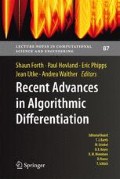Abstract
Automatic Differentiation (AD) is often applied to codes that solve partial differential equations, e.g. in geophysical sciences or Computational Fluid Dynamics. In agronomy, the differentiation of crop models has never been performed since these models are more empirical than fully mecanistic, derived from equations. This study shows the feasibility of constructing the adjoint model of a crop model referent in the agronomic community (STICS) with the TAPENADE tool, and the use of this accurate adjoint to perform some sensitivity analysis. This paper reports on the experience from AD users of the environmental domain, in which AD usage is not very widespread.
Access this chapter
Tax calculation will be finalised at checkout
Purchases are for personal use only
Notes
- 1.
- 2.
ADAM experiment (Data Assimilation through Agro-Modelling). Project and database at http://kalideos.cnes.fr/spip.php?article68
- 3.
All the parameters of STICS are described in http://www.avignon.inra.fr/agroclim_stics_eng/notices_d_utilisation
References
Baret, F., Vintila, R., Lazar, C., Rochdi, N., Prévot, L., Favard, J., de Boissezon, H., Lauvernet, C., Petcu, E., Petcu, G., Voicu, P., Denux, J., Poenaru, V., Marloie, O., Simota, C., Radnea, C., Turnea, D., Cabot, F., Henry, P.: The adam database and its potential to investigate high temporal sampling acquisition at high spatial resolution for the monitoring of agricultural crops. Romanian Agricultural Research 16, 69–80 (2001)
Brisson, N., Mary, B., Ripoche, D., Jeuffroy, M.H., Ruget, F., Nicoullaud, B., Gate, P., Devienne-Barret, F., Antonioletti, R., Durr, C., Richard, G., Beaudoin, N., Recous, S., Tayot, X., Plenet, D., Cellier, P., Machet, J.M., Meynard, J.M., Delecolle, R.: STICS: a generic model for the simulation of crops and their water and nitrogen balances. I: theory and parameterization applied to wheat and corn. Agronomie 18(5–6), 311–346 (1998)
Brisson, N., Ruget, F., Gate, P., Lorgeou, J., Nicoullaud, B., Tayot, X., Plenet, D., Jeuffroy, M.H., Bouthier, A., Ripoche, D., Mary, B., Justes, E.: STICS: a generic model for simulating crops and their water and nitrogen balances. II: model validation for wheat and maize. Agronomie 22(1), 69–92 (2002)
Castaings, W., Dartus, D., Le Dimet, F.X., Saulnier, G.M.: Sensitivity analysis and parameter estimation for distributed hydrological modeling: potential of variational methods. Hydrol. Earth Syst. Sci. 13(4), 503–517 (2009)
Griewank, A.: Achieving logarithmic growth of temporal and spatial complexity in reverse automatic differentiation. Optimization Methods and Software 1, 35–54 (1992)
Griewank, A., Walther, A.: Evaluating Derivatives: Principles and Techniques of Algorithmic Differentiation, 2nd edn. No. 105 in Other Titles in Applied Mathematics. SIAM, Philadelphia, PA (2008). URL http://www.ec-securehost.com/SIAM/OT105.html
Guérif, M., Houlès, V., Makowski, D., Lauvernet, C.: Data assimilation and parameter estimation for precision agriculture using the crop model STICS. In: D. Wallach, D. Makowski, J.W. Jones (eds.) Working with dynamic crop models: evaluating, analyzing, parameterizing and using them, chap. 17, pp. 391–398. Elsevier (2006)
Hascoët, L., Pascual, V.: TAPENADE 2.1 user’s guide. Rapport technique 300, INRIA, Sophia Antipolis (2004). URL http://www.inria.fr/rrrt/rt-0300.html
Houlès, V., Mary, B., Guérif, M., Makowski, D., Justes, E.: Evaluation of the ability of the crop model stics to recommend nitrogen fertilisation rates according to agro-environmental criteria. Agronomie 24(6), 339–349 (2004)
Ionescu-Bujor, M., Cacuci, D.G.: A comparative review of sensitivity and uncertainty analysis of large-scale systems. I: deterministic methods. Nuclear science and engineering 147(3), 189–203 (2004)
Lauvernet, C., Baret, F., Hascoët, L., Buis, S., Le Dimet, F.X.: Multitemporal-patch ensemble inversion of coupled surface-atmosphere radiative transfer models for land surface characterization. Remote Sens. Environ. 112(3), 851–861 (2008)
Le Dimet, F.X., Ngodock, H.E., Navon, I.M.: Sensitivity analysis in variational data assimilation. J. Meteorol. Soc. Japan pp. 145–155 (1997)
Le Dimet, F.X., Talagrand, O.: Variational algorithms for analysis and assimilation of meteorological observations: theoretical aspects. Tellus A 38A(2), 97–110 (1986)
Lions, J.L.: Optimal control of systems governed by partial differential equations. Springer-Verlag (1968)
Olioso, A., Inoue, Y., Ortega-FARIAS, S., Demarty, J., Wigneron, J., Braud, I., Jacob, F., Lecharpentier, P., Ottl, C., Calvet, J., Brisson, N.: Future directions for advanced evapotranspiration modeling: Assimilation of remote sensing data into crop simulation models and SVAT models. Irrigation and Drainage Systems 19(3–4), 377–412 (2005)
Rosenberg, N.J., Blad, B.L., Verma, S.B.: Microclimate: the biological environment. Wiley-Interscience (1983)
Ruget, F., Brisson, N., Delecolle, R., Faivre, R.: Sensitivity analysis of a crop simulation model, STICS, in order to choose the main parameters to be estimated. Agronomie v. 22(2) p. 133–158 (2002)
Saltelli, A., Chan, K., Scott, E.M.: Sensitivity Analysis. Wiley (2000)
Varella, H., Guérif, M., Buis, S.: Global sensitivity analysis measures the quality of parameter estimation: The case of soil parameters and a crop model. Environmental Modelling and Software 25(3), 310–319 (2010)
Verhoef, W.: Light scattering by leaf layers with application to canopy reflectance modeling: The SAIL model. Remote Sensing of Environment 16(2), 125–141 (1984)
Acknowledgements
This study was conducted thanks to a grant provided by CNES within the ADAM project (http://kalideos.cnes.fr/spip.php?article68), during the Ph.D. of the first author at INRA Avignon and the University of Grenoble.
Author information
Authors and Affiliations
Corresponding author
Editor information
Editors and Affiliations
Rights and permissions
Copyright information
© 2012 Springer-Verlag Berlin Heidelberg
About this paper
Cite this paper
Lauvernet, C., Hascoët, L., Le Dimet, FX., Baret, F. (2012). Using Automatic Differentiation to Study the Sensitivity of a Crop Model. In: Forth, S., Hovland, P., Phipps, E., Utke, J., Walther, A. (eds) Recent Advances in Algorithmic Differentiation. Lecture Notes in Computational Science and Engineering, vol 87. Springer, Berlin, Heidelberg. https://doi.org/10.1007/978-3-642-30023-3_6
Download citation
DOI: https://doi.org/10.1007/978-3-642-30023-3_6
Published:
Publisher Name: Springer, Berlin, Heidelberg
Print ISBN: 978-3-642-30022-6
Online ISBN: 978-3-642-30023-3
eBook Packages: Mathematics and StatisticsMathematics and Statistics (R0)

